Wine Lister has almost 150 new MUST BUYs. Since we launched MUST BUYs officially in September, the list has been updated based first on the most recent prices and relative regional or appellational value within vintages, and subsequently on Wine Lister’s most recent trips and tastings. The full MUST BUY list has reduced by 109 (1,693 wines vs. 1,802), and includes 149 new entries.
Perhaps unsurprisingly, 62 (or 42%) of new MUST BUYs hail from Burgundy. The 2017 vintage (released for the most part at the beginning of this year) yields 17 results, all worth getting hold of before availability reduces, and prices inevitably rise. Antoine Jobard achieves three mentions, all for 2017 Meursaults (Genevrières, Blagny, and Les Tillets), while Burgundy négociants are well-represented by additional MUST BUYs from Maisons Louis Latour, Louis Jadot, and Joseph Drouhin, who now count totals of 14, 42, and 20 MUST BUYs respectively. The Maisons de Négoce increasingly represent unparalleled value for money as the quality of their wines continues to increase, while their prices have not exploded in the same way as for many domaine wines.
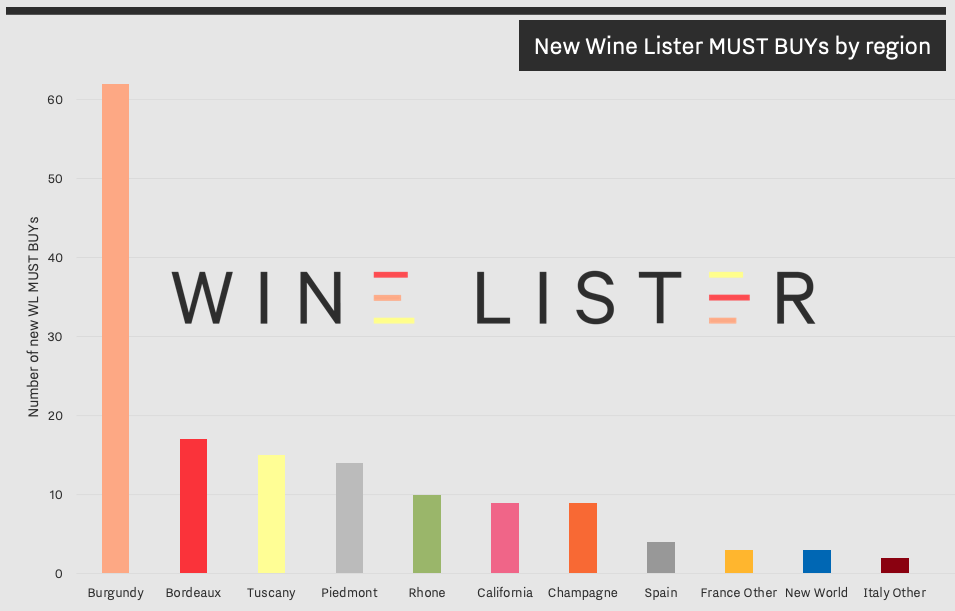
Bordeaux gains 17 new entries, including a 2018 en primeur listing – Domaine de Chevalier Blanc. The remaining new Bordeaux MUST BUYs are mainly older vintages, with premiers and deuxièmes crus from 1982-1999 that are worth uncovering ahead of the festive season. Two Value Picks stand out from the Wine Lister team’s own tasting experiences of late – Capbern 2014 and Haut Carles 2015.
Italy reaps particular success in this new round of MUST BUYs, with 31 listings in total, split between Piedmont (14), Tuscany (15), Veneto (1), and Sicily (1). Gaja leads the charge in Piedmont with two vintages a piece for Barolo Sperss (2005 and 2014), and Barbaresco Sorì San Lorenzo (2005 and 2007). In Tuscany, a fourth vintage of Soldera’s Case Basse makes it into the MUST BUY list (1999), alongside existing MUST BUY vintages 2008, 2009, and 2013. The indomitable Castello dei Rampolla also gains an additional vintage each for Sammarco (1991), and Alceo (2008), making it the most “essential” producer to buy in Italy.
The Wine Lister team was pleased to be able to select from new wines rendered by the MUST BUY algorithm a few gems from recent tastings, including Deutz Cuvée William 2008 and Pierre Péters Cuvée Spéciale Les Chétillons Blanc de Blancs 2010 from a recent trip to Champagne, and Cheval des Andes 2016 – one of the team’s favourites from the September releases through the Place de Bordeaux.
All MUST BUYs are qualified by a minimum quality level, but at the very top of the new MUST BUY scoreboard are 16 wines with WL scores of 97 and above. While Burgundy outperforms Italy in number of new MUST BUYs, they each earn five places in the top scorers, as shown below.
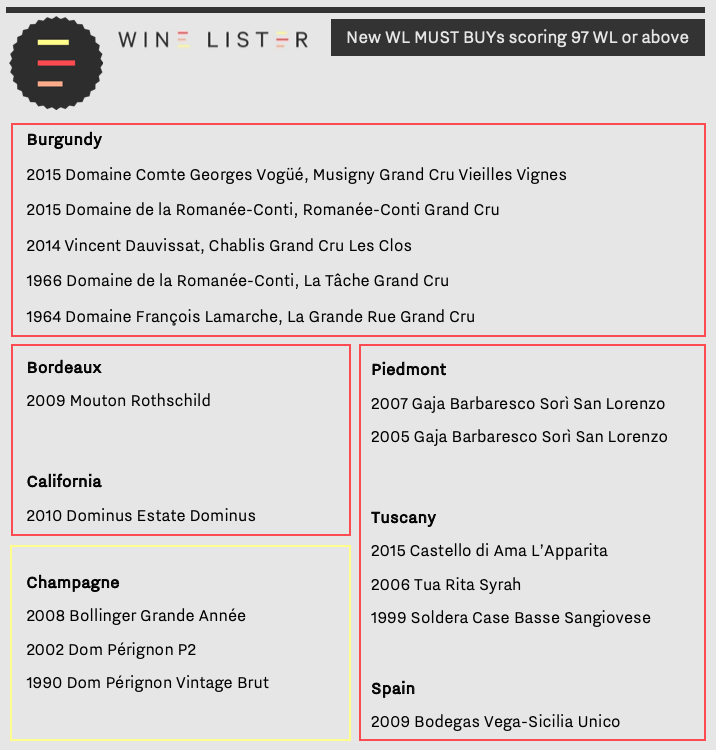
See the full list of MUST BUYs here, and watch this space for weekly MUST BUY updates from here on in.
Wine Lister is excited to announce the arrival of its new consumer site, aimed at supporting fine wine lovers as they navigate the fine wine seas. All users now have unlimited, free access to the world’s most comprehensive fine wine data hub. Start learning how to buy wine like a pro now, or read on to find out more.
WL MUST BUYs
Wine Lister has created its own buy recommendation tool, which combines Wine Lister data with human intelligence (such as the opinion of key members of the global fine wine trade, plus insight from the Wine Lister team’s trips and tastings), to provide a dynamic list of wines any fine wine buyer should consider for their cellar. All MUST BUYs represent high quality, and value within their respective appellations and vintages.
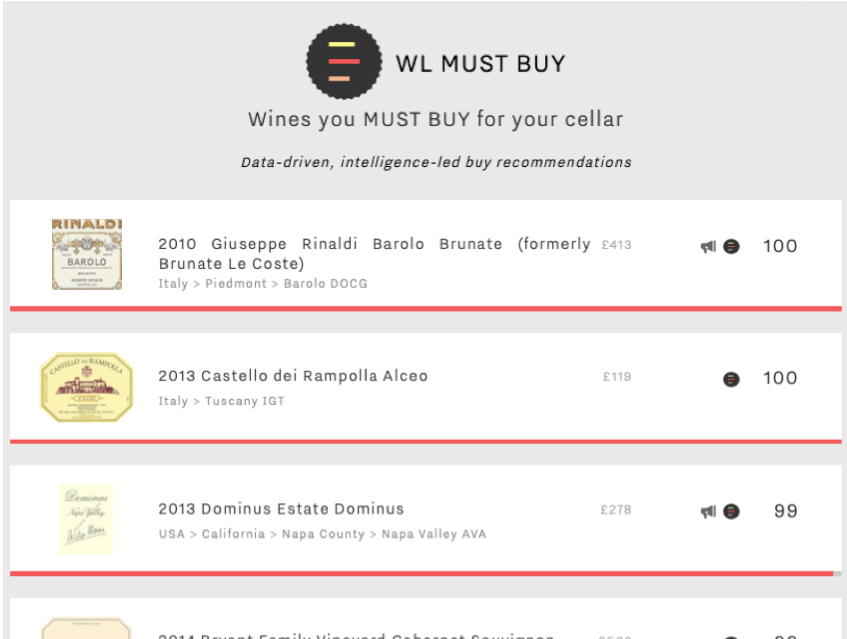 Browse the full MUST BUY list here.
Browse the full MUST BUY list here.
Aggregated, 100-point score
With a focus on quality, the new 100-point Wine Lister Score combines the ratings of five of the world’s most respected wine critics – Jancis Robinson, Antonio Galloni and Neal Martin (Vinous), Bettane+Desseauve, and Jeannie Cho Lee, together with a smaller weighting for the wine’s ageing potential. The score is as objective an indication of wine quality as possible, allowing users to make site-wide comparisons across the 30,000+ wine-vintages on Wine Lister.
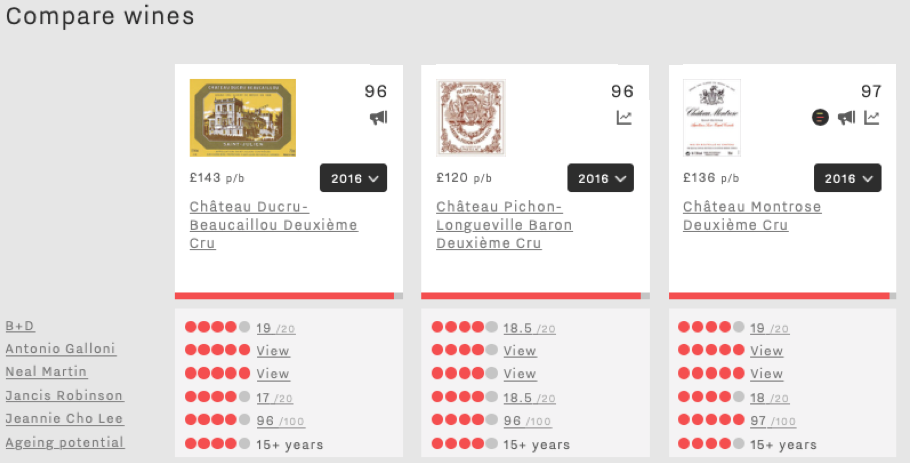
See this comparison, or create your own here.
Further analysis tools
Dynamic charts give users the chance to explore wines they might consider buying or selling in more detail.
The Vintage Value Identifier gives users a clear visual of price to quality ratios across vintages of a given wine, applying a score to this measure of relative value. See the example below for Mouton Rothschild: while the 2016 vintage is higher quality than 2014, its accompanying high price means that both the 2016 and 2014 vintages present the same level of value (the joint-highest of all recent back vintages shown)
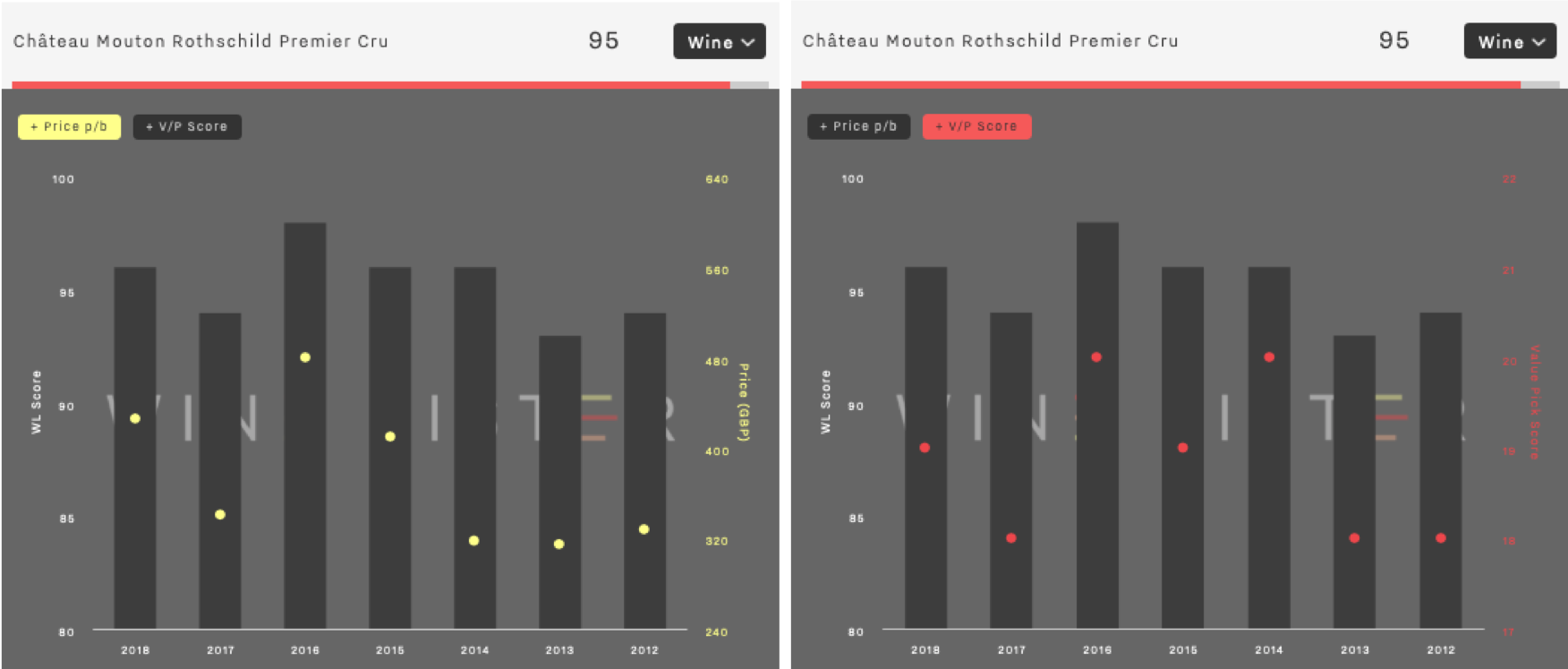 Wine Lister’s dynamic Vintage Value Identifier chart, showing price vs. quality (left) and Value Pick score (right).
Wine Lister’s dynamic Vintage Value Identifier chart, showing price vs. quality (left) and Value Pick score (right).
See the chart for Mouton Rothschild, or search for another wine here.
The Price History chart tracks a wine’s price performance over time, relative to its peer group. This can be done at vintage level, helping collectors to see performance history of a specific wine they might own. See below the example of Domaine Hubert Lignier’s Clos de La Roche 2016, whose price growth over the last year is one of the most impressive of all wines on Wine Lister (57.8%).
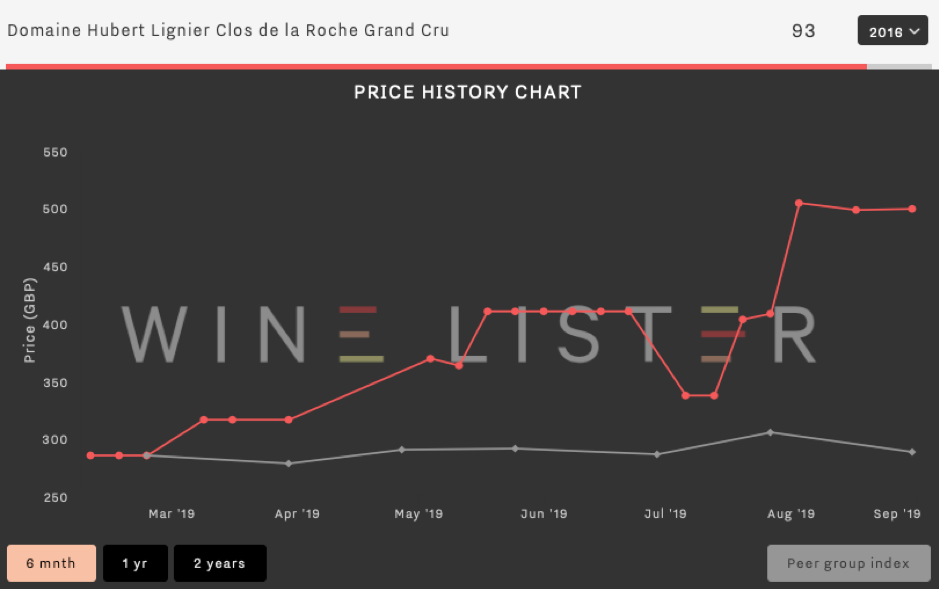 Hubert Lignier Clos de la Roche 2016’s six-month price performance compared to performance of other Clos de la Roche Grand Cru 2016s
Hubert Lignier Clos de la Roche 2016’s six-month price performance compared to performance of other Clos de la Roche Grand Cru 2016s
The same dynamic chart can be used at wine level (an average across vintages, with a stronger weighting for more recent vintages), to give a general indication of a wine’s price trajectory, and therefore whether or not the wine in question could be an investment buy. See below an example for Armand Rousseau’s Chambertin, which on average sees steady price growth, and a CAGR (compound annual growth rate) of 31.8% (though the price has flattened out this year).
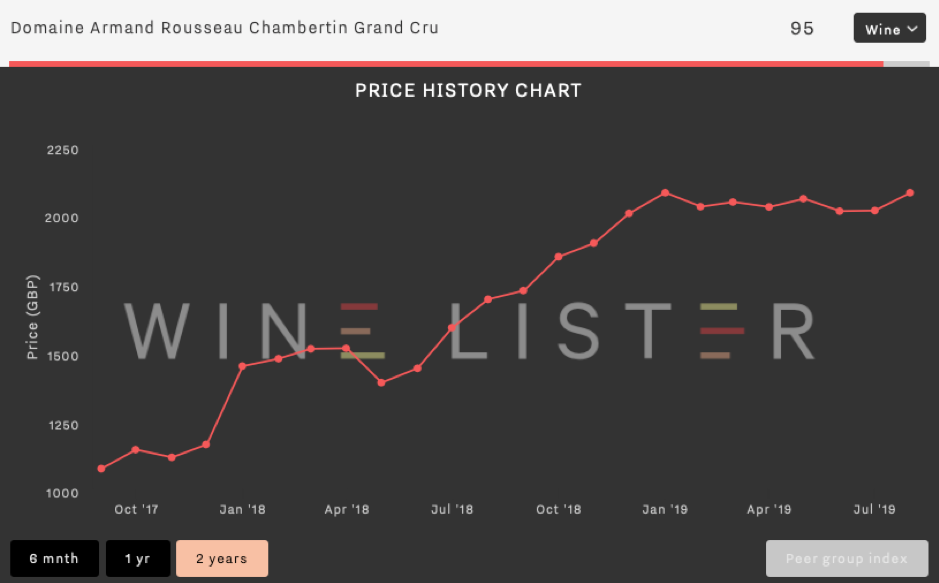 Armand Rousseau’s average price performance over two years
Armand Rousseau’s average price performance over two years
On top of these tools, each wine page gives users further information about the wine in question, including whether the wine qualifies for one of Wine Lister’s four Indicators. Haut Brion, as shown in the example below, is a Buzz Brand. See more information on other segments – Hidden Gems, Value Picks, and Investment Staples, or start browsing here.

We hope that you find the new site informative and useful for developing your fine wine collection. Feedback from our users is always welcome – please don’t hesitate to contact us with any questions or comments here.
The Bordeaux 2018 en primeur campaign is over. While the quality of wines available is, for the most part, unquestionably good, release prices have been on the high side to say the least, making the benefit of buying en primeur less obvious than in previous years.
Wine Lister’s brand-new website feature, WL MUST BUY, was launched this week*, especially for Bordeaux 2018 wines, to give valuable guidance as to which wines really are worth snapping up now.
Our ground-breaking MUST BUY recommendations are data-driven, with an intelligence-based, human overlay. The algorithm takes into account a wine’s quality and value within its vintage and appellation, as well as the latest industry intelligence from key players in the global fine wine trade. The Wine Lister team have scoured these results to identify must-buy wines based on our own tastings of Bordeaux 2018s, and insider market knowledge.
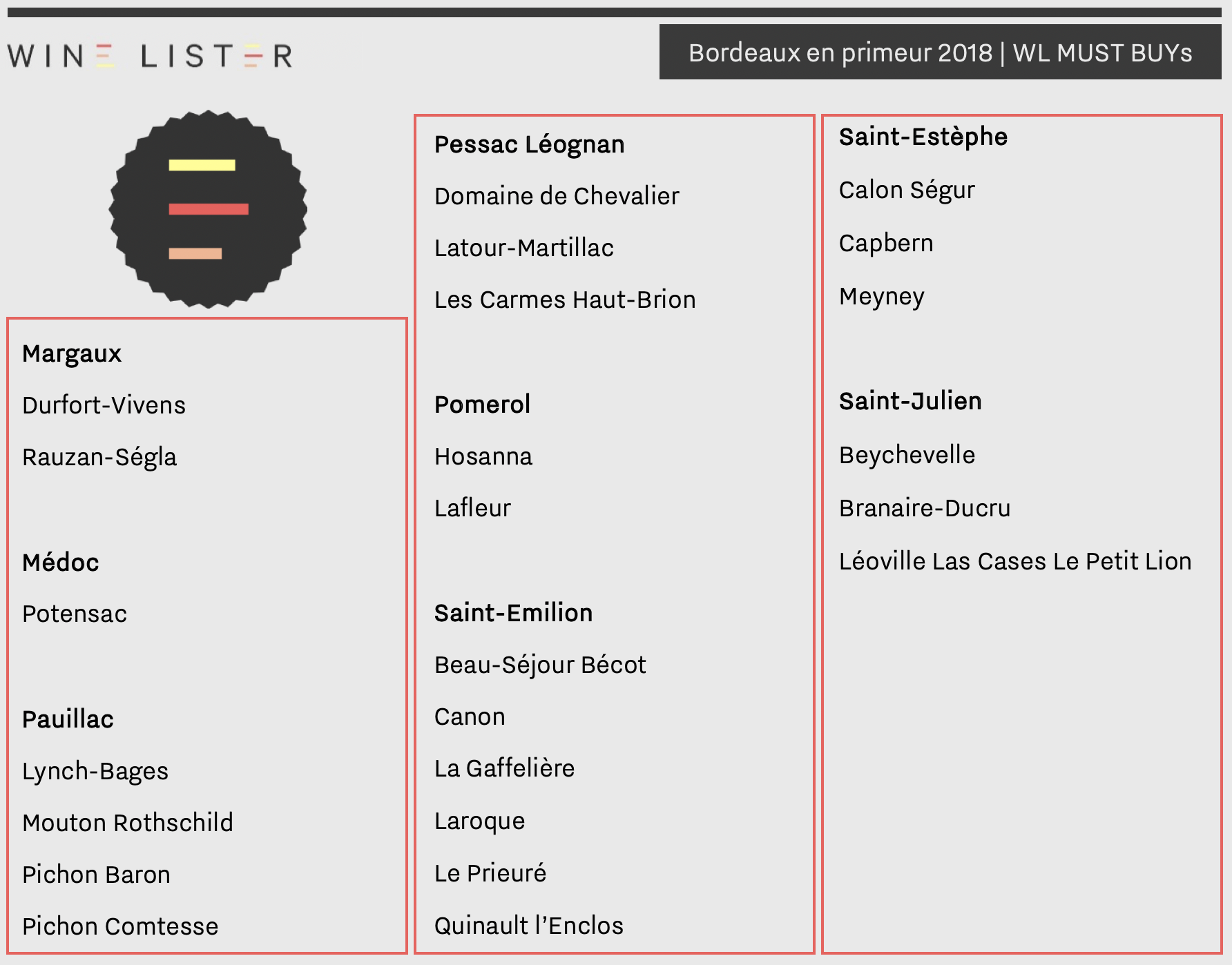
Given the dominance of reds in the top Bordeaux 2018 Quality scores, it is no surprise that all of these WL MUST BUYs are red.
Saint-Emilion ranks as our most recommended appellation, with six WL MUST BUYs, including the indomitable Canon, and value successes Le Prieuré, Quinault l’Enclos, and Laroque. These three achieve WL MUST BUY status by first passing the quality filter of Wine Lister’s MUST BUY algorithm (they exceed their collective Quality score average by 192 points in 2018). Their respective prices relative to similar quality 2018s from Saint-Emilion push them through the algorithm’s second step – the value filter. Finally, they have been identified by the fine wine trade and/or the Wine Lister team as wines to watch: Quinault l’Enclos is made by the elite winemaking team of Cheval Blanc, and their best yet, while Laroque has been taken to new heights by winemaker David Suire (who cut his teeth at Larcis-Ducasse).
Pauillac houses four of the “top end” Bordeaux 2018 MUST BUYs – Mouton (released at £426 per bottle in bond), both powerhouse super-seconds, Pichon Baron and Pichon Comtesse, and Buzz Brand Lynch Bages.
Sharing three picks apiece are further left bank appellations Saint-Julien, Saint-Estèphe, and Pessac-Léognan. Capbern, Meyney, and Latour-Martillac are testament to the value proposition available in Saint-Estèphe and Pessac-Léognan respectively. Saint-Julien MUST BUYs are represented by two fourth-growth staples, Branaire-Ducru and Beychevelle, and the second wine of Léoville Las Cases, Le Petit Lion.
Margaux earns two MUST BUYs – Rauzan-Ségla, and biodynamic Durfort Vivens (who made a huge step up in quality this year, and whose 2018 yield was less than a quarter of its usual volume). Pomerol equals this number with Lafleur and Hosanna.
Other wines featured in Wine Lister’s Bordeaux 2018 MUST BUYs list are: Beau-Séjour Bécot, Calon Ségur, Domaine de Chevalier Rouge, La Gaffelière, Les Carmes Haut-Brion, and Potensac.
*Wine Lister launched its MUST BUY tool on Monday at a Telegraph event entitled “Wine for Pleasure or Profit?”, where founder & CEO Ella Lister spoke about going “Back to Bordeaux” for both. You can see slides from the presentation relevant to Bordeaux 2018 MUST BUYs here: Telegraph Back to Bordeaux


 Browse the full MUST BUY list
Browse the full MUST BUY list 
 Wine Lister’s dynamic Vintage Value Identifier chart, showing price vs. quality (left) and Value Pick score (right).
Wine Lister’s dynamic Vintage Value Identifier chart, showing price vs. quality (left) and Value Pick score (right). Hubert Lignier Clos de la Roche 2016’s six-month price performance compared to performance of other Clos de la Roche Grand Cru 2016s
Hubert Lignier Clos de la Roche 2016’s six-month price performance compared to performance of other Clos de la Roche Grand Cru 2016s Armand Rousseau’s average price performance over two years
Armand Rousseau’s average price performance over two years 
